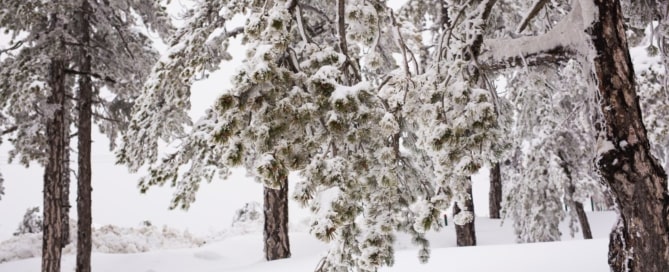With the cold weather around the corner, it’s time to start thinking about winter tree care.
Now, that’s not to say trees aren’t resilient. They go dormant in the winter, much like hibernating animals. Even then, the icy temperatures and frosty conditions is still stressful for trees.
This is especially important for recently planted trees, which are not fully established. These trees are more susceptible to winter damage because they haven’t developed a solid root system.
Fortunately, with enough planning and preparation, you can help your beloved trees survive winter.
Add Mulch
Mulching isn’t just for landscaping projects during the warmer months. Come winter, mulch insulates your trees by increasing the temperature of the soil. This stops the soil from cracking, which protects the roots. Essentially, mulch is a blanket for trees.
Timing is everything, though. Mulch just before the ground freezes. Otherwise, pests and rodents will turn the mulch into their new winter home.
When you do mulch, add a two- or three-inch layer under your tree’s drip line. Avoid mulching too deep or up against the trunk. If you’re unsure how to mulch the right way, contact a professional tree company like Friendly Tree.
Water Throughout Fall
Again, preparation is key. During the fall season, make sure your trees are regularly watered. This is even more vital for newly planted trees.
Continue watering the trees until the ground freezes — around late October or November. From there, water them once or twice a month. You should also only water them under the following conditions:
- The temperature is 40 degrees Fahrenheit or higher
- There isn’t any ice or snow on the ground nearby
- It’s early in the day, which allows enough time for absorption
If you have evergreen trees, water them during winter droughts. Since they lose moisture through their needles, these trees need to store more water.
Fall Pruning
Winter tree branch care starts with smart fall pruning. Before the new season begins, remove weak and dying branches. This will minimize future breakage, especially during intense window and ice buildup.
Fall pruning not only improves the aesthetics of your tree, but it makes them safer too. As always, work with a certified arborist to ensure that your trees are properly pruned.
Wrap Tree Trunks
To protect your trees from the frigid winter nights, use winter tree wraps. These wraps will keep tree trunks warm during the chilly weather.
They’ll also prevent sunscald, a condition that damages the trunk. Sunscald happens when the tree trunk freezes at night, then thaws under the winter sun. When it freezes again at night, the cells in the bark can burst and cause cracking.
Tree wraps also stop rodents, rabbits, and other animals from chewing on your tree trunks.
It’s best to install the tree wraps in late fall or early winter, before the first freeze. You can leave them on until late winter or early spring.
Remove Snow
While you’re shoveling the driveway, don’t forget to remove the snow from tree branches. Otherwise, snow can build up and break branches.
Gently remove the snow with a soft broom. You can also carefully push the branch upward until the snow falls off. If the branch has ice, spray it with warm water through a garden hose. Never try to remove ice from a branch.
Friendly Tree Will Help You Weather The Winter Season
Although New Jersey winters can be brutal, it’s possible to protect your trees from seasonal damage. It comes down to proper winter tree care and being vigilant about tree maintenance.
If you’re not sure where to start, get in touch with Friendly Tree. Our experienced New Jersey arborists can examine your trees and offer winter survival tips according to their age, health, and species. With this personalized guidance, you can give your trees the best protection possible during the frosty weather.
To schedule a consultation, contact Friendly Tree at (973) 678-8888.



Recent Comments